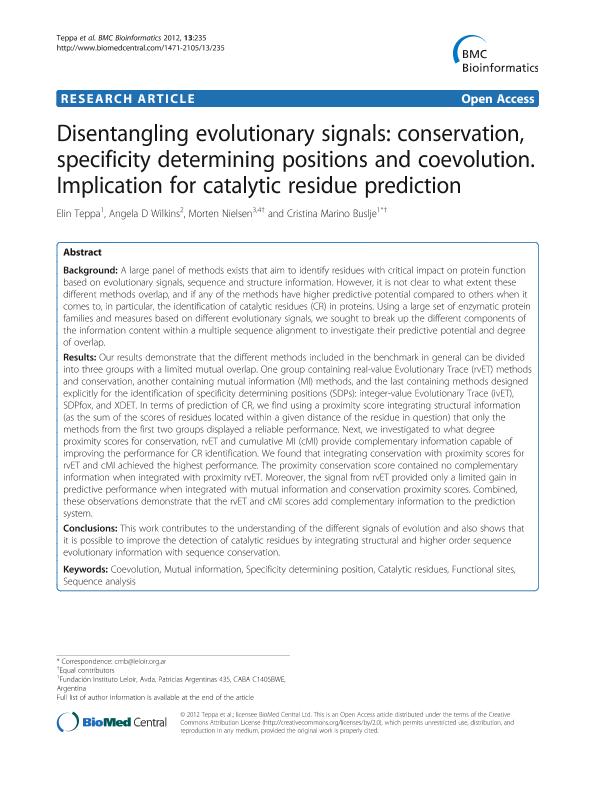Artículo
Disentangling evolutionary signals: conservation, specificity determining positions and coevolution. Implication for catalytic residue prediction
Fecha de publicación:
09/2012
Editorial:
BioMed Central
Revista:
BMC Bioinformatics
ISSN:
1471-2105
e-ISSN:
1471-2105
Idioma:
Inglés
Tipo de recurso:
Artículo publicado
Clasificación temática:
Resumen
Background: A large panel of methods exists that aim to identify residues with critical impact on protein function based on evolutionary signals, sequence and structure information. However, it is not clear to what extent these different methods overlap, and if any of the methods have higher predictive potential compared to others when it comes to, in particular, the identification of catalytic residues (CR) in proteins. Using a large set of enzymatic protein families and measures based on different evolutionary signals, we sought to break up the different components of the information content within a multiple sequence alignment to investigate their predictive potential and degree of overlap.Results: Our results demonstrate that the different methods included in the benchmark in general can be divided into three groups with a limited mutual overlap. One group containing real-value Evolutionary Trace (rvET) methods and conservation, another containing mutual information (MI) methods, and the last containing methods designed explicitly for the identification of specificity determining positions (SDPs): integer-value Evolutionary Trace (ivET), SDPfox, and XDET. In terms of prediction of CR, we find using a proximity score integrating structural information (as the sum of the scores of residues located within a given distance of the residue in question) that only the methods from the first two groups displayed a reliable performance. Next, we investigated to what degree proximity scores for conservation, rvET and cumulative MI (cMI) provide complementary information capable of improving the performance for CR identification. We found that integrating conservation with proximity scores for rvET and cMI achieved the highest performance. The proximity conservation score contained no complementary information when integrated with proximity rvET. Moreover, the signal from rvET provided only a limited gain in predictive performance when integrated with mutual information and conservation proximity scores. Combined, these observations demonstrate that the rvET and cMI scores add complementary information to the prediction system.Conclusions: This work contributes to the understanding of the different signals of evolution and also shows that it is possible to improve the detection of catalytic residues by integrating structural and higher order sequence evolutionary information with sequence conservation. © 2012 Teppa et al.; licensee BioMed Central Ltd.
Archivos asociados
Licencia
Identificadores
Colecciones
Articulos(IIBBA)
Articulos de INST.DE INVEST.BIOQUIMICAS DE BS.AS(I)
Articulos de INST.DE INVEST.BIOQUIMICAS DE BS.AS(I)
Citación
Teppa, Roxana Elin; Wilkins, Angela D.; Nielsen, Morten; Marino Buslje, Cristina; Disentangling evolutionary signals: conservation, specificity determining positions and coevolution. Implication for catalytic residue prediction; BioMed Central; BMC Bioinformatics; 13; 1; 9-2012; 1-8
Compartir
Altmétricas




